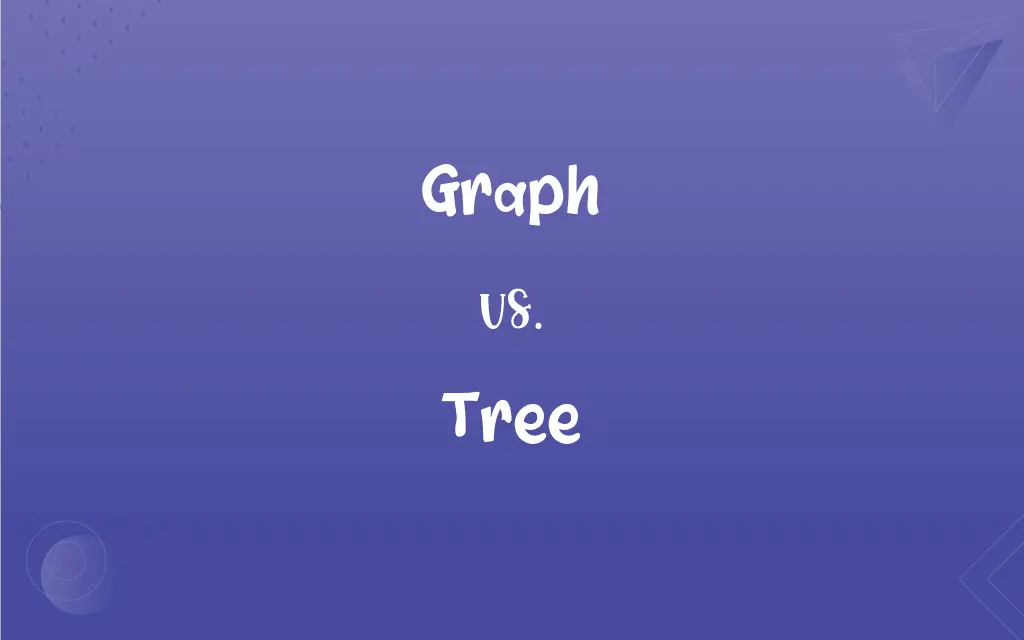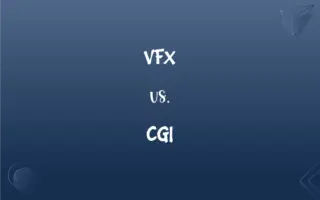Graph vs. Tree: What's the Difference?
Edited by Aimie Carlson || By Harlon Moss || Published on February 13, 2024
A graph is a collection of nodes connected by edges without any specific hierarchy, whereas a tree is a hierarchical structure of nodes with a single root and no cycles.

Key Differences
Graphs and trees are structures used to represent relationships. A graph is a set of vertices (or nodes) connected by edges, allowing for various types of connections and structures. In contrast, a tree is a type of graph with a hierarchical structure, starting from a root node, and each node (except the root) is connected to exactly one parent node.
In graph theory, graphs can have cycles, meaning a path exists where a node can be visited more than once. Trees, as a subset of graphs, do not have cycles; there is only one path between any two nodes, ensuring a strict hierarchy.
Graphs can be either directed or undirected, indicating if the relationships between nodes have a specific direction. Trees are inherently directed, with edges typically directed from parent to child.
Graphs are used in numerous applications like social networks, transportation networks, and neural networks, where relationships can be complex and non-linear. Trees are used in scenarios like organizational structures, file systems, and decision trees, where a clear, hierarchical structure is needed.
The complexity of algorithms in graphs and trees also differs. Graph algorithms, such as for finding the shortest path, can be more complex due to the possibility of cycles and multiple paths. Tree algorithms, like tree traversal, are usually simpler due to their hierarchical, non-cyclical nature.
ADVERTISEMENT
Comparison Chart
Structure
Nodes connected by edges, can form cycles
Hierarchical, no cycles, with a single root
Direction of Connections
Can be directed or undirected
Always directed from parent to child
Paths between Nodes
Multiple paths possible, can have cycles
Single unique path between nodes
Application Examples
Social networks, transportation networks
Organizational charts, file systems
Algorithmic Complexity
Generally more complex due to cycles
Simpler due to hierarchical structure
ADVERTISEMENT
Graph and Tree Definitions
Graph
A diagram showing the relation between variable quantities.
The temperature over the week was shown in a line graph.
Tree
A branching diagram representing hierarchical relationships.
The family tree showed generations of ancestors.
Graph
A visual representation of data.
The sales data was plotted on a graph for analysis.
Tree
A woody perennial plant with a single main stem or trunk.
The oak tree in the yard is over 100 years old.
Graph
A tool in computer science to model pairwise relations.
The computer algorithm used a graph to optimize the network.
Tree
A structure in computer science resembling a tree.
The data was organized into a binary search tree.
Graph
A mathematical structure of nodes connected by edges.
The graph represents the network of city roads.
Tree
A graph with no cycles and a single root.
The tree structure efficiently managed the network hierarchy.
Graph
A drawing illustrating the variation of a variable.
He drew a graph to show the population growth.
Tree
A tool for representing decisions and their possible consequences.
They used a decision tree to evaluate business strategies.
Graph
A diagram that exhibits a relationship, often functional, between two sets of numbers as a set of points having coordinates determined by the relationship. Also called plot.
Tree
(Computers) A structure for organizing or classifying data in which every item can be traced to a single origin through a unique path.
Tree
(graph theory) A connected graph with no cycles or, if the graph is finite, equivalently a connected graph with n vertices and n−1 edges.
Tree
(computing theory) A recursive data structure in which each node has zero or more nodes as children.
Tree
(graphical user interface) A display or listing of entries or elements such that there are primary and secondary entries shown, usually linked by drawn lines or by indenting to the right.
We’ll show it as a tree list.
FAQs
Can a tree have loops or cycles?
No, trees cannot have loops or cycles.
Are all trees graphs?
Yes, all trees are a specific type of graph with hierarchical structure.
What is a tree in computer science?
A tree is a hierarchical data structure with a single root and no cycles.
Can a graph have cycles?
Yes, graphs can have cycles unless they are trees.
What is a binary tree?
A binary tree is a tree where each node has at most two children.
What is a graph in mathematics?
A graph is a set of vertices connected by edges, representing relationships.
How are graphs used in real life?
Graphs are used to model networks like social, transportation, and neural networks.
How do trees help in decision-making?
Trees, like decision trees, help in visualizing and organizing decisions and their consequences.
What is a root in a tree?
The root is the topmost node in a tree from which all other nodes branch out.
Can graphs represent complex relationships?
Yes, graphs can model complex and multi-dimensional relationships.
Can graphs be directed or undirected?
Yes, graphs can be either directed or undirected.
Are trees always binary?
No, trees can have any number of children per node, not just two.
Are graphs used in algorithms?
Yes, graphs are widely used in various algorithms for network analysis, optimization, etc.
Can a graph have disconnected parts?
Yes, a graph can have disconnected components.
What is a subtree?
A subtree is a portion of a tree containing a node and all its descendants.
What is a graph in computer science?
A graph in computer science is a data structure used to represent pairwise relationships.
How are trees used in data structures?
Trees are used to organize data hierarchically, allowing efficient data storage and retrieval.
What is a leaf in a tree?
A leaf is a node in a tree that has no children.
Are trees simpler than graphs in structure?
Yes, trees are simpler than general graphs due to their hierarchical, non-cyclical nature.
Can trees be used to model networks?
Trees can model hierarchical networks but are less suited for complex, interconnected networks.
About Author
Written by
Harlon MossHarlon is a seasoned quality moderator and accomplished content writer for Difference Wiki. An alumnus of the prestigious University of California, he earned his degree in Computer Science. Leveraging his academic background, Harlon brings a meticulous and informed perspective to his work, ensuring content accuracy and excellence.
Edited by
Aimie CarlsonAimie Carlson, holding a master's degree in English literature, is a fervent English language enthusiast. She lends her writing talents to Difference Wiki, a prominent website that specializes in comparisons, offering readers insightful analyses that both captivate and inform.































































